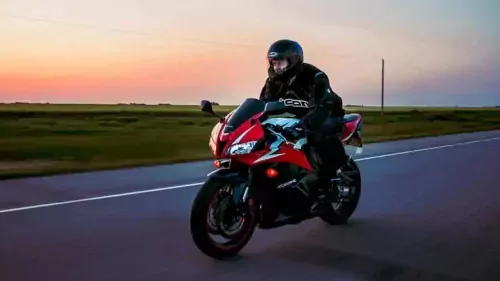
If you or someone you know is just getting into motorcycling, there’s so much to learn. Maybe you’re not a new rider, but you have had a recent, let’s say, “unplanned offroading experience” and are thinking some (or some better) gear may have improved that outcome. Choosing good riding gear can seem like an enormous obstacle, but we’re here to break it down for you, and give you some general information so that you can make informed choices.
Good gear will keep you comfortable in a wide range of situations, and when you’re comfortable you’re a better rider. Gear that is uncomfortable, ill-fitting, or otherwise fails at its intended purpose is at best a distraction, and the last thing a motorcyclist needs is a distraction.
Why Bother?
Motorcycle gear is more than just protection in case of a crash - it's your armour against the harsh elements. With every ride you're exposed to sun, rain and wind that can take its toll on any rider; but with reliable motorcycle gear, you can be sure your skin will remain protected from potentially harmful UV rays and potential deafness or worse caused by flying debris. So when gearing up for those exciting rides ahead, remember: stay safe...stay armoured!
When it comes to motorcycling, one of the most important benefits is crash protection. Many riders who have come close to disaster can attest: it's better to be safe than sorry! Our bodies just aren't built for high-speed impacts - let alone anything faster than running as a kid when you'd scrape your knees and rip your jeans (ouch!). With speeds many times greater on bikes, protective gear becomes even more crucial in allowing us all the enjoy this thrilling pastime safely.
Helmets
Wearing a helmet while riding a motorcycle is essential to staying safe, but not all helmets offer the same level of protection. A study by Dietmar Otte reveals that almost half of impacts suffer on the unprotected face and chin area when wearing an open-face or three-quarter type helmet – making it critical for riders to choose wisely with full-face options being ideal in many cases. But if you need greater convenience, modular helmets are becoming increasingly popular due to their ability protect as efficiently as full faces yet still keep wind, bugs and sun off your eyes during rides.
According to the manufacturers, helmets have a five-year life. After that, the adhesives and materials that provide impact absorption can begin to degrade, impacting the performance of the helmet when it counts.
When you wear a helmet, it is designed to protect your head – but if subjected to an impact with enough force, the energy may be absorbed by its destruction instead. It's important not to purchase used helmets, as even though they might appear undamaged on the surface there could have been unseen effects incurred in any prior crashes. Therefore never sacrifice safety for cost! Remember too that simply bashing into walls can weaken or harm your new protective gear; however dropping them from short heights should cause no real worry - unless someone’s noggin happens to be inside at the time of course.
Choose the right helmet for the kind of riding you plan to do. Street helmets and dirt helmets are purpose made, and will protect you better, and keep you comfortable, in their own environment.
The minimum legal standard for a street helmet in the US is a DOT rating. You’ll see the sticker affixed prominently on the back. That’s just a minimum legal standard, though. Two other voluntary standards exist in the United States: “ECE 22.05” is the European Union’s legal standard, and the Snell Foundation also tests helmets in the US.
Many manufacturers offer high-quality, high-spec helmets that don’t cost a fortune. More expensive helmets have better paint quality, fancy graphics, better ventilation, and more comfortable liners, but are not necessarily safer.
The shape and size of every person’s head is unique. Spend the time to find a helmet that fits you perfectly; sizes and shapes vary heavily between manufacturers and models. Other considerations to bear in mind are weight, noise, and aerodynamics. You’ll find those addressed in motorcycle helmet reviews.
Jackets
Motorcycle jackets are made of leather and/or textile. High-quality textile materials are able to resist abrasion as strongly as leather, and often include water-resistant membranes capable of keeping you dry in bad weather. Textile jackets are often more affordable. Leather is more durable, but not as adjustable for comfort in all kinds of weather.
Motorcycle-specific jackets come with features you won’t find elsewhere: seams are doubled up to protect the stitching from abrasion and increase strength; they’re designed to fit snugly in high-speed wind blast so they don’t flap around; they have adjustable air vents. They should also have body armor with a CE safety rating—impact absorbing material that cushions your most vulnerable parts in a crash
The jacket should fit snugly but leave your arms free to articulate fully. Consider the style of bike you ride and choose a jacket cut to work in its riding position. Think about what kind of weather you’ll most frequently be riding in. Jackets made from mesh, perforated leather, or with lots of vents are good for warm weather but not the cold or wet, and vice versa.
Some jackets feature zippers around the bottom, or at the back, enabling them to connect to a pair of riding pants. This keeps the jacket from riding up in a crash. If your jacket zipper doesn’t match your pants, your local tailor can take care of that for you.
Pants
Regular denim jeans will not protect you in a motorcycle accident. Cotton has less than a quarter of the abrasion resistance of leather or good textile riding pants.
Generally, textile riding pants are made from Cordura, which is the name brand for a highly abrasion resistant type of nylon fabric. Jeans that include Kevlar panels offer more abrasion resistance, but are still a compromise, offering nothing like the protection of a true pair of riding pants.
Like jackets, pants are available in leather or textile materials and should be equipped with CE-rated armor in the hips and knees. They should fit snugly, but be comfortable. Try them on a bike, or stand in a riding position close to that of your own to determine if they’ll work, and make sure the armor stays in the right place and does not dig in.
Boots
Think about how much your motorcycle weighs. You’ll need to support that through your legs, ankles, and feet on slippery, uneven, unpredictable surfaces. For that reason alone, a sturdy pair of boots with oil-resistant, non-slip soles and good ankle support should be considered a minimum. To see what will happen to your feet in a crash, in a given pair of footwear, grasp them by the toe and heel, then twist. If the result doesn’t look like your foot would survive intact, then it probably won’t.
The best riding boots will prevent that twisting. Strong heel and toe boxes help reduce the force of impacts to those areas. Armor over the ankle and shin protects those areas. Any boot considered for riding a motorcycle should at least cover your ankle, and securely. Anything less and it will likely fly off in an accident, offering zero protection.
Gloves
Your hands extremely fragile. Unfortunately, evolution dictates that they’re the first thing to touch down in any crash: your hind-brain has programmed you to protect your head at the expense of your hands. Good gloves should cover your hands completely. They should be made of strong, abrasion-resistant materials and strong, protected stitching. Shoddy, uneven stitching and thin leather is a sign of a glove that will give up on impact. Armor at the base of the palm is a great feature; this is where your hands will land in a crash. Make sure any glove you choose allows you to operate the controls on your bike unimpeded.








